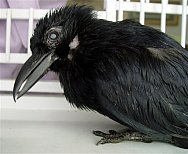 This month’s Scientific American has, among other fascinating stories, an article on the vision of birds. It turns out that they are able to sense colors in the ultraviolet spectrum, having inherited four cone pigments from our common vertebrate ancestor. As mammals evolved, four was reduced to two, and later a third one came to be. All this means is that our feathered friends are able to see a vastly greater number of colors and recognize patterns where it all looks the same to us. There are a large number of birds in which we have trouble telling a female from a male as they look almost identical. Not so for them: with the added UV element added the differences become very clear. Of course we cannot even begin to imagine how birds and other animals sense the world around us: color is after all the product of the brain interpreting input from the eyes, not a property of light. Color-blind people have to make do with what nature has given them; we all seem to be in that position when compared to species that are more advanced than us in this department.
This month’s Scientific American has, among other fascinating stories, an article on the vision of birds. It turns out that they are able to sense colors in the ultraviolet spectrum, having inherited four cone pigments from our common vertebrate ancestor. As mammals evolved, four was reduced to two, and later a third one came to be. All this means is that our feathered friends are able to see a vastly greater number of colors and recognize patterns where it all looks the same to us. There are a large number of birds in which we have trouble telling a female from a male as they look almost identical. Not so for them: with the added UV element added the differences become very clear. Of course we cannot even begin to imagine how birds and other animals sense the world around us: color is after all the product of the brain interpreting input from the eyes, not a property of light. Color-blind people have to make do with what nature has given them; we all seem to be in that position when compared to species that are more advanced than us in this department.Seeing color is an interesting sensation. In many individuals it is closely connected to other senses. A person may see lights before the onset of a migraine headache or an epileptic seizure. Some of us see colors when listening to music or other sounds, like in my own case. Different pitches and keys are not only sensed by the ear: the brain also translates them into hues of color. Some music can be visually very pleasing, some other evoking ugly images enough to make one ill. I don’t know if this ‘gift’ is a blessing or a curse. People who are happy with just plowing ahead with whatever music they are listening to or playing are probably just as lucky as a person who can’t tell whether he is wearing a red shirt or a green one. After all, sensitivity can be a distraction: in music the most basic elements (loud-soft, fast-slow, short-long) are often all that seem to be required. Many leaders are ruthless and desensitized: when deciding to send soldiers to fight one cannot think of all the resulting suffering. There would be no wars if leaders had sensitivity and emotions; a conscience in other words.
The oldest crow in the world just croaked at the age of 59. It had lived all these years in captivity as a pet, having fallen out of its nest in a cemetery during a thunderstorm in 1947, never having been able to fly as a result of injury. That bird hadn’t seen ultraviolet or any other colors for a long time as it had been blinded by cataracts. Had Tata the Crow lived in Seattle instead of N.Y. State, based on this city’s rationale, he might have become a key figure for Boeing (a bird must be an expert in aviation even if he can’t fly), keeping his prominent role for all those decades (after all, with all those years of experience he must have been very insightful, even when blind). Who knows, perhaps he would have also become a star in the local music scene, a Ta-Ta. We all know what a magnificent singing voice a crow possesses!
Picture of 'Tata' by Kristine Flones